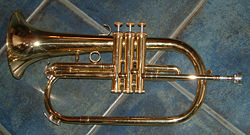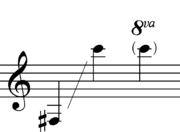Flugelhorn
 |
|
| Classification | *Wind
|
|---|---|
| Playing range | |
 |
|
| Related instruments | * Trumpet
|
The flugelhorn (also spelled fluegelhorn or flügelhorn) is a brass instrument resembling a trumpet but with a wider, conical bore. Some consider it to be a member of the saxhorn family developed by Adolphe Sax (who also developed the saxophone); however, other historians assert that it derives from the keyed bugle designed by Michael Saurle (father), Munich 1832 (Royal Bavarian privilege for a "chromatic Flügelhorn" 1832), thus predating Adolphe Sax's innovative work.[1]
Contents[hide] |
Etymology
The original German spelling, Flügelhorn, translates into English as wing horn. Purportedly the instrument was used on the battlefield to summon the flanks, or wings, of an army.[2]
Structure and variants
The flugelhorn is built in the same B-flat pitch as many trumpets and cornets. It usually has three piston valves and employs the same fingering system as other brass instruments, but four valve and rotary valve variants also exist. It can thus be played without too much trouble by trumpet and cornet players, though some adaptation to their playing style may be needed. It is usually played with a more deeply conical mouthpiece than either trumpets or cornets (though not as conical as a horn mouthpiece).
Some modern flugelhorns are built with a fourth valve, which takes them down in pitch a perfect fourth (similar to the fourth valve sometimes found on euphoniums, tubas, horns and piccolo trumpets, as well as the trigger on trombones). This adds a useful area of low range which, when coupled with the flugelhorn's dark sound, gives an interesting extension to the instrument's abilities. More often, however, the fourth valve is used in place of the first and third valve combination, which is somewhat sharp (which is compensated for on trumpets and cornets and some three-valve flugelhorns by a slide for the first or third valve).
Timbre
The tone is "fatter" and usually regarded as more "mellow" and "dark" than that of the trumpet or cornet. The sound of the flugelhorn has been described as approximately halfway between a trumpet and a horn, whereas the cornet's sound has been described as approximately halfway between a trumpet and a flugelhorn[3]. The flugelhorn has a similar level of agility to the cornet but is more difficult to control in the high register (from approximately written G above the staff), where in general it "slots" or locks onto notes less easily. It is not generally used for aggressive or bright displays as both trumpet and cornet can be, but tends more towards a softer and more reflective role.
Use
The flugelhorn's main areas of use are in jazz, the brass band, and popular music, although it does appear occasionally in orchestral writing. Some of the more famous orchestral works with flugelhorn include Ottorino Respighi's Pines of Rome, Igor Stravinsky's Threni, Ralph Vaughan Williams's Ninth Symphony, and Michael Tippett's third symphony. The flugelhorn is sometimes substituted for the post horn in Mahler's Third Symphony. The flugelhorn figured prominently in many of Burt Bacharach's 1960s pop song arrangements. Flugelhorns have occasionally been used as the alto or low soprano voice in a drum and bugle corps. This is increasingly rare, however.
Famous players
Joe Bishop, as a member of the Woody Herman band in 1936, was one of the earliest jazz musicians to make use of the flugelhorn. Shorty Rogers and Kenny Baker began playing it in the early fifties, and Clark Terry used it with Duke Ellington's orchestra in the middle fifties. Miles Davis helped further to popularize the instrument in jazz on the albums Miles Ahead and Sketches of Spain, both of which were arranged by Gil Evans, although he did not use it much on later projects. Other prominent jazz flugelhorn players include Freddie Hubbard, Lee Morgan, Art Farmer, Hugh Masekela, Tony Guerrero, Jimmy Owens, Chet Baker, Maynard Ferguson, Terumasa Hino, Woody Shaw, Kenny Wheeler, Tom Harrell, Bill Coleman, Thad Jones, Lee Loughnane of the rock band Chicago, and Harry Beckett. Most jazz flugelhorn players use the instrument as an auxiliary to the trumpet, but in the 1970s Chuck Mangione gave up playing the trumpet and concentrated on the flugelhorn alone.
Pop flugelhorn exponents include Rick Braun, Mic Gillette, Jeff Oster, and Zach Condon.
Footnotes
- ↑ "History of the flugelhorn". Retrieved on 2007-06-23.
- ↑ "Flugelhorn at dictionary.com".
- ↑ Cecil Forsyth: Orchestration, p. 165.
References
- Ralph T. Dudgeon, Franz X. Streitwieser: The Fluegelhorn. Edition Bochinsky, 2004, English/German, ISBN 3932275837
- "Flugelhorn", The New Grove Dictionary of Music and Musicians, second edition, edited by Stanley Sadie and John Tyrrell (London, 2001).
- "Flugelhorn", The New Grove Dictionary of Jazz, second edition, edited by Barry Kernfeld (London, 2002).
External links
- An enthusiast's flugelhorn guide with many details of individual makes.
- An overview and brief history of the flugelhorn including a short sound clip.